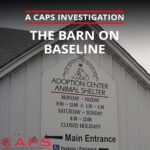Breeder: Mast, Ivan and Katie
Business name: Mini-Mountain Kennel
City, State Zip: Millersburg, OH 44654
Year: 2005
USDA License: 31-A-0110
Date of CAPS Investigation: 2005-03-03
Approximately eight dogs. Breeds: Bichon Frises, West Highland Terriers, Beagles
The main kennel building at the Masts’ property was about eight feet long and four feet wid. It had plastic siding and a shingled roof. Along each eight-foot wall were two rows of four cages with one row set on top of the other. Each cage had an indoor and outdoor pen connected by a metal doggie-door. There were four adult Bichons and two adult West Highland Terriers housed here with one dog per cage. Each dog had a metal chain around its neck with a metal tag on it. One of the adult Bichons had hair loss in an area about six inches in diameter around its back (2.40-Vet Care).
The outdoor cages were made entirely of treated thin-gauge wire. Plastic sheets curved from the wall to a foot under the cages to catch feces and debris, and it was obvious more than 24 hours’ accumulation of feces was beneath each occupied cage (3.11(a)-Cleaning of primary enclosures). Underneath each bottom sheet was more than a month’s accumulation of feces (3.11(a) Cleaning of primary enclosures). Four-inch-wide PVC pipes ran from the ends of each sheet facing away from the owners’ house to the ground. The pipes from both sides of the building connected and extended about five feet to a snow-covered pile of feces about four inches deep (3.1(f)-Drainage and waste disposal). Feces and clumps of fur were caked into the crevices between the pipes and the building just below the plastic sheets (3.11(a)-Cleaning of primary enclosures).
An end cage on a bottom row had mangled wire, bent up and down in waves and protruding in sharp points in two places at the top of the cage (3.1(a)-Structure, construction). The roof of another bottom cage was mangled in a similar manner with the wire pushed away from the kennel wall (3.1(a)-Structure, construction); (3.6(a)(2)(i)-Primary enclosures).
The inside cages were made with treated thin-gauge wire with plastic boards between the cages. Plastic sheets were placed beneath the cages and angled downward to catch feces and debris. The sheets were stained with feces and fur (3.1(c)(2)-Surfaces).
Each cage had a plastic tub about 1.5 wide, 1.5 feet long, and four inches high. While many of these tubs had feces-smeared bottoms (3.11(a)-Cleaning of primary enclosures), several had blankets in them. Plastic plates about eight inches wide and long were on them (3.11(a)-Cleaning of primary enclosures). Each cage an empty plastic self feeder attached to it, and a lix-it watering system fed a water spigot in each cage. The tops of several cages had wire bent down a few inches into the cages (3.1(a)-Structure, construction).
There was a Beagle enclosure about 20 feet from the kennel. This outdoor pen was five feet wide, 12 feet long and surrounded by five-foot-high chain-link fencing. Inside were two adult Beagles and a plastic barrel about 1.5 feet wide and three feet long. The plastic barrel had no bedding inside (3.4(b)(4)-Shelter from the elements) and was not large enough for both Beagles to occupy at once and lie in a normal manner or turn about freely (3.4(b)-Shelter from the elements). It had a wooden board set in front of it to hold it in place and no windbreak on its entrance (3.4(b)(3)-Shelter from the elements). There was an empty plastic food dish and a plastic water dish filled with ice (3.10-Watering).




